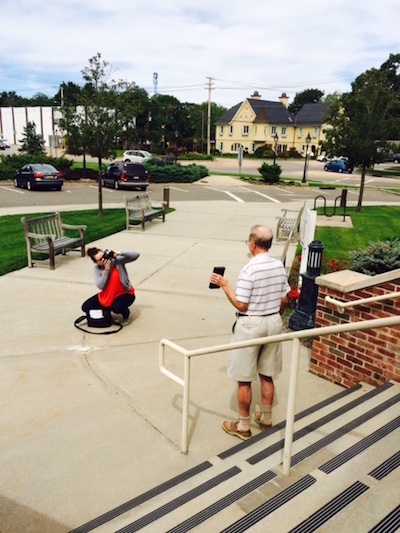Southampton Press/27east.com reporter Erin McKinley interviewed this reporter on the steps of Westhampton Beach Village Hall Aug. 8 on our demands that Wi-Fi routers in the Library and Village Hall be shut down.
McKinley noted that our advice has been ignored for “several months” by officials at both the library and WHB.
|
|
Her 812-word piece has drawn nine replies thus far including one from David Ashton of ukelectrosensitives, based in London, who has compiled extensive research on the issue and who is quoted below.
The McKinley article noted we have quoted Cindy Sage, Ph.D., and Dr. Martha Herbert, Harvard professor who specializes in pediatric autism and neurology, on the dangers of radiation.
WHB Deputy Mayor Ralph Urban told McKinley that WHB would have to “further vet the information that has been shared by Mr. O’Dwyer before considering any action.”
“I am not sure that his statistics merit any kind of action, basically,” Urban told McKinley. “We would have to look into it a great deal more rather than just taking his word for it.”
Also quoted in the article is Westhampton Free Library Director Danielle Waskiewicz who noted the library board, headed by Tom Moore, husband of WHB Mayor Maria Moore, has said at several public meetings that it has “no intention of removing its routers unless it is determined that they pose a serious threat to people.” Tom Moore has noted that the Federal Communications Commission has found that Wi-Fi radiation does not heat human tissues and is therefore harmless.
Mayor Moore is not quoted in the article.
Routers are in the ceiling throughout the library on both the first and second floors (children’s area). The room on the first floor where 64 seniors play bridge each Tuesday and where the library board meets once a month shows six volts per square meter of pulsed radiation, the highest possible on an Acoustimeter.
Stony Brook Medical Doctor Sees No Danger
Dr. Samuel Ryu, chair of the Dept. of Radiation Oncology, Stony Brook Medicine and deputy director, Clinical Affairs, Stony Brook University Cancer Center, told McKinley there are “no recognized studies linking the radiation emitted by Wi-Fi systems to diseases like cancer.”
|
|
He said the strength of radiation emitted is far too weak to alter human DNA. Frequent exposure to much stronger rays such as X-rays or gamma rays would be needed to harm a person.
Ashton posted on the McKinley story as follows:
Credit to Mr O'Dwyer for his persistence on this crucial issue, and for his coverage on his website.
Anyone in an environment with wi-fi who sees the radiation readings on a meter for themselves, or who hears the audible racket on an acoustic setting, would probably have a problem resting easy about the subject again.
With respect to Dr. Samuel Ryu, he seems to be unaware of a few facts, which he might like to look into.
1) Radiofrequency/microwave radiation is classified by the International Agency for Research on Cancer (IARC) as a Group 2B carcinogen, along with lead, DDT, and exhaust fumes. This doesn't automatically mean that exposure to wi-fi radiation causes cancer, but nor does it give it a clean bill of health, despite what Dr Ryu says. Incidentally, IARC recently confirmed that their classification wasn't restricted to cellphones, but applied to all wireless technologies emitting radiofrequency/microwave radiation, such as wi-fi.
2) France has banned children under 3 being exposed to wi-fi in nurseries and public places on health grounds, and restricts the exposure of older children.
3) Turin is planning to restrict wi-fi on health grounds.
4) The insurance industry refuses to cover risks associated with exposure to this radiation. I wonder why.
5) Last year, the International EMF Scientist Appeal was signed by 190 experts on the biological effects of this radiation, and the number of signatories has since grown to 221. It was sent to the UN, all UN member states, and the World Health Organisation. It warned of an "...emerging public health crisis related to cell phones, wireless devices, wireless utility meters and wireless infrastructure in neighborhoods".
The Appeal also noted that:
"Numerous recent scientific publications have shown that EMF affects living organisms at levels well below most international and national guidelines. Effects include increased cancer risk, cellular stress, increase in harmful free radicals, genetic damages, structural and functional changes of the reproductive system, learning and memory deficits, neurological disorders, and negative impacts on general well-being in humans. Damage goes well beyond the human race, as there is growing evidence of harmful effects to both plant and animal life."
6) The preliminary results of the National Toxicology Program, just released, appear to confirm that non-ionising radiation can promote cancer - in rats at least. If true, this would mean that the regulatory concensus that the radiation is safe so long as it doesn't heat the body by more than a certain amount is fatally undermined.
There is so much more information out there - the Bioinitiative Report summarises thousands of scientific studies, and proposes new, biologically-based, exposure levels.
It's somewhat surprising that we don't already have these, of course, and that the technology has proliferated before it has been proven to be safe...
Health Advocate Doucette Adds Advice
Cecelia Doucette, a resident of Ashland, Mass., who has created a 23-minute video that tells people how to lessen dangerous radiation in their homes, posted as follows on the 27east.com story:
Hopefully residents will take the time to become educated on this important issue. Three years ago an electrical engineer friend tipped me off there could be potential harm from wi-fi. I had run many campaigns to raise funds to bring technology into our schools so I asked our school leaders about it. They too had never heard of the health impact, but after investigating and reading the fine print that comes with each device, our school committee in Ashland, MA put into place Best Practices for Mobile Devices. The Environmental Health Trust tells us we are the first in the nation to do so and I get calls regularly now from parents all over the country catching on to wi-fi's harm after their children become ill who are also educating their schools.




 Lo Isidro, senior director at Real Chemistry with more than a decade of strategic communications and PA experience, has joined Narrative Strategies.
Lo Isidro, senior director at Real Chemistry with more than a decade of strategic communications and PA experience, has joined Narrative Strategies. Nelson Fernandez, former North American chair of APCO Worldwide and managing director of Burson-Marsteller, has joined Volunteers in Medicine Berkshires as director of communications and PA.
Nelson Fernandez, former North American chair of APCO Worldwide and managing director of Burson-Marsteller, has joined Volunteers in Medicine Berkshires as director of communications and PA. Lilit Bargar, who was most recently an EVP in the healthcare practice at Weber Shandwick, comes on board at GCI Health as EVP, corporate practice lead.
Lilit Bargar, who was most recently an EVP in the healthcare practice at Weber Shandwick, comes on board at GCI Health as EVP, corporate practice lead.
 Five ways that successful thought leaders are made.
Five ways that successful thought leaders are made.


 Have a comment? Send it to
Have a comment? Send it to 
When we need to use a mobile device, best practice is to keep it in airplane mode except when actively transmitting data, and keep any active devices as far from the body as possible. Speaker phone or a hollow/airtube headset is recommended.
We can read emails and compose texts in airplane mode, then just go into active mode to send/receive data, and set it back to airplane mode as the norm. The alarm clock, calculator, camera, downloaded music/books/games, etc., are all still accessible in airplane mode, but without the radiation. Please, never give a child a device in active mode, and never place an active device near a pregnant woman or in a baby stroller.
Do your best to keep your sleeping areas a sanctuary above all else. Wi-fi radiation prevents our bodies from doing proper cell repair and restoration while we sleep, and this is being shown to cause a host of health issues ranging from sleep problems, chronic fatigue, social/emotional issues, headaches, nausea, nose/ear bleeds, skin problems, ear ringing, concentration, behavioral issues and more in the short-term. In the long-term, it is being tied to not only cancers, but infertility, miscarriages, DNA damage, neurotoxicity, genotoxicity and more.
I have built a research repository on-line to keep track of the science, etc., but this Comments section doesn't allow one to post a URL. I believe if you search "Cece Doucette google site Understanding EMFs" you can access it to learn more. Thank you for your time and consideration.